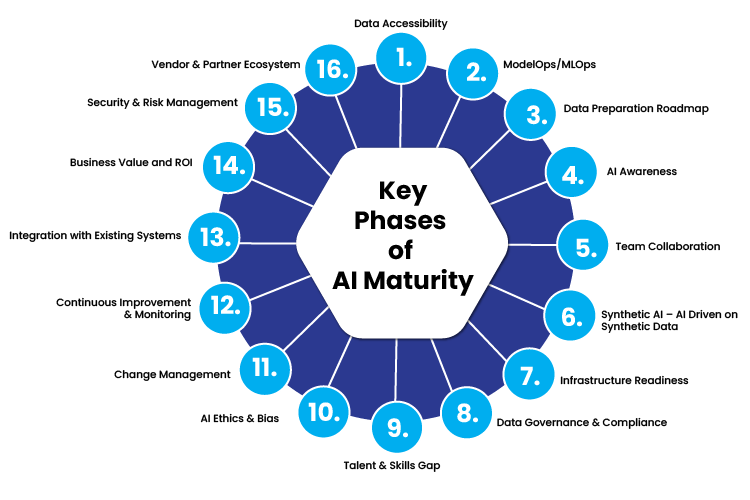

N. Kranthi Kumar
9 Minutes read
From AI Experimentation to AI Engineering: The Path to AI Maturity
Artificial intelligence (AI) has rapidly transitioned from a cutting-edge technology to a critical driver of business transformation. Just a decade ago, AI was predominantly confined to academic research and experimental projects. Today, it is an integral part of business strategies, revolutionizing industries from healthcare to finance, and redefining operational efficiencies, customer experiences, and decision-making processes.
The Evolution of Artificial Intelligence
The background of AI’s evolution highlights its journey from early explorations into machine learning and neural networks to the development of sophisticated algorithms that can analyze vast amounts of data, recognize patterns, and make predictions. Initially, companies dipped their toes into AI with small-scale experiments and proof-of-concept projects, testing the waters to understand its potential and feasibility. These early efforts often involved simple applications, such as chatbots or recommendation engines, and provided valuable insights into AI’s capabilities and limitations.
However, moving from these initial experiments to deploying AI at scale involves navigating a host of challenges. Companies must manage the complexities of integrating AI solutions into existing systems, ensuring data accessibility, and addressing concerns around model performance and reliability. The gap between experimental AI and production-ready systems can be daunting, requiring advancements in infrastructure, data management, and operational processes.
Furthermore, as AI becomes more embedded in business operations, the need for a strategic approach to AI engineering becomes paramount. Organizations must not only demonstrate the tangible business value of AI but also address regulatory compliance, ethical considerations, and talent gaps. This transition demands a comprehensive understanding of the various elements involved in scaling AI from a promising prototype to a mature, enterprise-grade solution.
In this evolving landscape, exploring these challenges and understanding the key areas of AI engineering are essential for achieving AI maturity. By effectively addressing these aspects, companies can transform AI from an experimental endeavor into a robust, impactful component of their business strategy, driving long-term innovation and success.
Key Phases of AI Maturity
Successfully transitioning from AI experimentation to mature engineering requires addressing several critical aspects to ensure effective implementation and long-term success. This blog explores the key aspects of this journey, providing insights into how organizations can advance from basic AI experimentation to sophisticated AI engineering, and ultimately achieve AI maturity.

Data Accessibility
One of the foundational elements of successful AI projects is data accessibility. For AI models to perform effectively, they need high-quality, relevant data that is easily accessible. However, many organizations struggle with data silos, where data is scattered across different systems and departments, making it challenging to aggregate and utilize.
To overcome this challenge, businesses must implement strategies to ensure that data is not only collected but also organized and made readily accessible. This involves investing in robust data infrastructure and adopting data management practices that facilitate easy data retrieval and integration. Additionally, organizations should focus on data governance to maintain data quality and integrity.
ModelOps & MLOps
As organizations move from AI experimentation to engineering, establishing a comprehensive roadmap for ModelOps and MLOps becomes crucial. ModelOps focuses on managing the lifecycle of AI models, from development to deployment and monitoring. MLOps extends this to cover the operational aspects of machine learning, including automation, version control, and scalability.
Data Preparation Roadmap
Developing a clear roadmap for these processes helps ensure that AI models are efficiently managed and maintained. This involves setting up pipelines for data preparation, model training, and deployment, as well as implementing monitoring mechanisms to track model performance and address issues promptly.
AI Awareness
Educating higher management about AI is essential for driving successful AI initiatives. Leaders must understand the benefits, limitations, and challenges associated with AI to make informed decisions and support AI projects effectively.
Business leaders should be involved in the AI strategy from the outset, ensuring that AI initiatives align with organizational goals and have the necessary resources and support. This requires ongoing education and communication to keep management informed about the latest developments and best practices in AI.
Team Collaboration
Effective AI solutions often require collaboration between various teams, including data engineers, software engineers, and subject matter experts (SMEs). Data engineers and software engineers provide the technical expertise needed to build and deploy AI models, while SMEs contribute domain-specific knowledge that ensures the solutions are relevant and effective.
Fostering collaboration between these groups helps ensure that AI solutions are well-rounded and address real-world challenges. This collaboration should be structured and facilitated through regular meetings, shared objectives, and clear communication channels.
Synthetic AI – AI Driven on Synthetic Data
Synthetic data, generated through simulations or other techniques, is becoming an increasingly important resource for training AI models. It offers several advantages, including the ability to create large datasets without privacy concerns and to simulate rare or extreme scenarios that may not be present in real-world data.
Organizations exploring synthetic data should assess its suitability for their specific use cases and integrate it into their data strategies accordingly. This may involve developing methods for generating and validating synthetic data and incorporating it into the overall data pipeline.
Infrastructure Readiness
The scalability and performance of infrastructure are critical considerations for AI engineering. As AI models become more complex and require more computational power, organizations must ensure that their infrastructure can handle these demands.
Choosing between cloud-based solutions and on-premise infrastructure involves weighing factors such as cost, security, and flexibility. Cloud solutions offer scalability and lower upfront costs, while on-premise solutions provide greater control and potentially better security.
Data Governance and Compliance
Data governance and regulatory compliance are paramount for AI projects. Organizations must adhere to data privacy laws such as GDPR and CCPA, ensuring that personal data is handled appropriately and securely.
Data quality and integrity are also crucial. AI models are only as good as the data they are trained on, so ensuring that data is accurate, consistent, and reliable is essential for effective AI performance.
Talent and Skills Gap
The AI talent landscape is highly competitive, and organizations must invest in upskilling and reskilling their employees to keep pace with technological advancements. Building cross-functional teams that include data scientists, data engineers, software engineers, and domain experts helps foster innovation and collaboration.
Attracting and retaining top AI talent requires offering ongoing training opportunities and creating an environment that supports continuous learning and professional development.
AI Ethics and Bias
Ensuring fairness and transparency in AI models is critical to addressing ethical concerns and building trust with users. AI systems must be designed to avoid bias and provide transparent decision-making processes.
Organizations should develop ethical guidelines and frameworks to address issues such as job displacement, surveillance, and autonomous systems. This includes establishing mechanisms for auditing and evaluating AI models to ensure they align with ethical standards.
Change Management
Integrating AI into business operations often requires a cultural shift within the organization. Managing resistance to change and fostering a culture that embraces AI and innovation is crucial for successful implementation.
Securing buy-in from stakeholders at all levels, from the C-suite to frontline employees, helps ensure that AI initiatives are supported and effectively integrated into the organizational fabric.
Continuous Improvement and Monitoring
AI models are not static; they require continuous monitoring and improvement to maintain their effectiveness. Implementing mechanisms to detect and address model drift—where performance degrades over time—is essential for sustaining AI performance.
Feedback loops should be established to gather insights from real-world usage and user feedback, allowing for ongoing refinement and enhancement of AI models.
Integration with Existing Systems
Integrating AI solutions with existing legacy systems and ensuring interoperability with other technologies is a key consideration. AI systems should be designed to work seamlessly within the broader technological ecosystem of the organization.
This involves assessing compatibility with existing systems, addressing potential integration challenges, and ensuring that AI solutions can effectively interact with other platforms and technologies.
Business Value and ROI
Defining clear metrics to measure the business value and ROI of AI initiatives is essential for justifying investments and demonstrating success. Pilot projects can help validate the potential impact of AI before committing to larger-scale implementations.
By measuring impact and demonstrating value through pilot projects, organizations can build a stronger case for broader AI adoption and ensure that AI initiatives align with strategic business objectives.
Security and Risk Management
AI systems must be protected from cyber threats and risks. Ensuring robust cybersecurity measures and conducting thorough risk assessments helps safeguard AI systems and data.
Organizations should implement security protocols and risk management strategies to identify and mitigate potential risks associated with AI implementation, ensuring the resilience and security of their AI infrastructure.
Vendor and Partner Ecosystem
Building strategic partnerships with AI vendors, technology providers, and research institutions can enhance an organization’s AI capabilities. Leveraging external expertise and integrating AI solutions with a broader ecosystem of partners helps drive innovation and expand the scope of AI initiatives.
Conclusion
The path from AI experimentation to AI engineering and maturity is a multifaceted journey that requires careful planning, execution, and ongoing refinement. By addressing key aspects such as data accessibility, model management, talent development, ethics, and integration, organizations can navigate this journey effectively and unlock the full potential of AI.
As businesses continue to evolve and adapt in the rapidly changing AI landscape, a strategic approach to AI engineering will be essential for achieving long-term success and maintaining a competitive edge. By embracing these considerations and fostering a culture of innovation, organizations can pave the way for a future where AI is seamlessly integrated into their operations and drives meaningful value and impact.
For the latest updates or additional information, feel free to contact ACL Digital.



